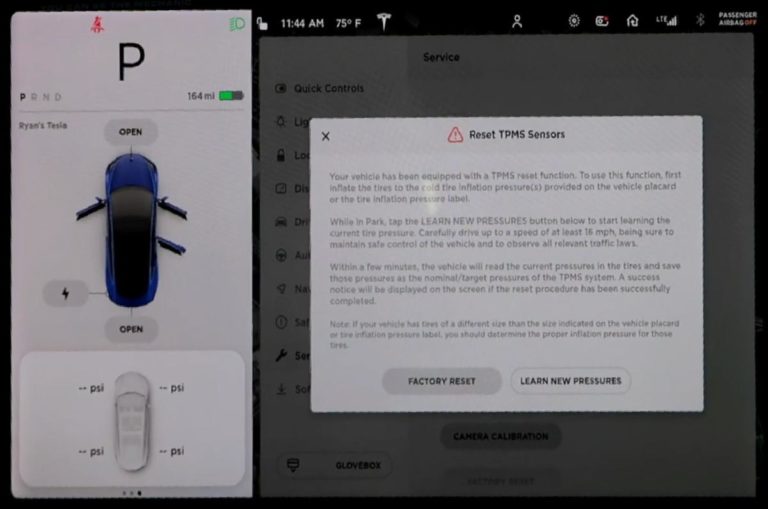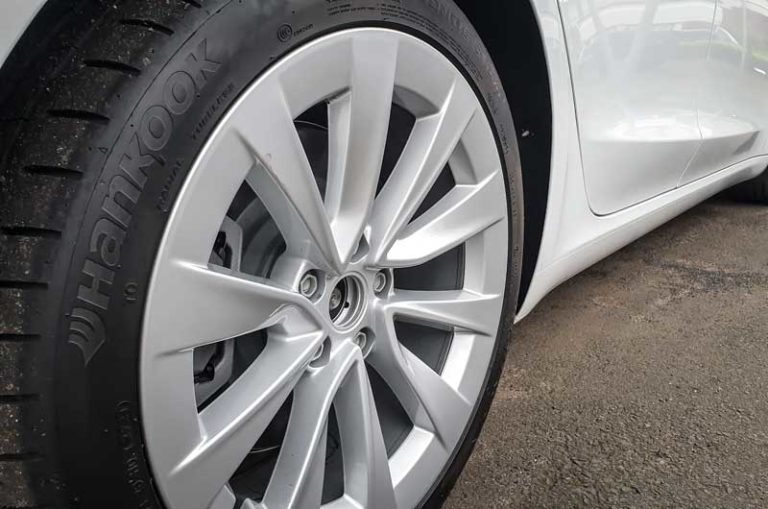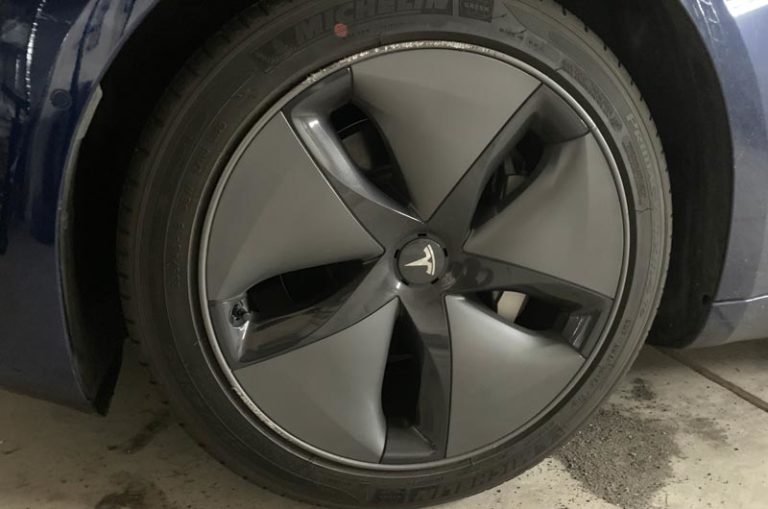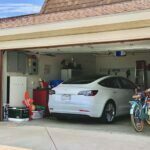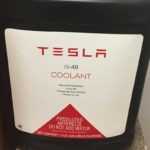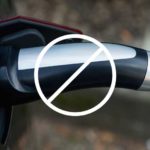Did you know that several factors can contribute to your Tesla’s tires wearing out faster than expected? From the vehicle’s heavy weight to the type of tires used, there are several reasons why this may be happening. But don’t worry – there are also things you can do to extend the life of your tires. So, is the lifespan of Tesla tires shorter than average?
Tesla tires can wear out faster than expected due to heavy vehicle weight, aggressive driving style, low rolling resistance tires, lack of rotations/alignments, road conditions, and a regenerative braking system. Regular maintenance and proper driving habits can help extend tire life. Consider alternative tire options based on driving style and weather conditions.
In this article, I will discuss 6 reasons why your Tesla’s tires might be wearing out faster than you expected, and provide tips on how to reduce their impact. Whether you’re a new Tesla owner or a seasoned veteran, this article will help you better understand the factors affecting your tires and how to keep them in top shape. So let’s dive in!
Why Your Tesla’s Tires Might Be Wearing Out Faster
1. Heavy Weight of the Vehicle
Tesla cars are known for their heavy weight due to the large battery packs that power their electric motors. This weight can have a significant impact on tire wear. The heavier the vehicle, the more stress is put on the tires when driving, which can cause them to wear out more quickly.
Effect of Weight on Tire Lifespan
When a car’s weight puts stress on its tires, it can cause them to wear down more quickly. This is because the tire’s contact patch—the area of the tire that touches the road—increases.
This can cause more friction and heat buildup,m which can cause the tire’s tread to wear out faster. This can lead to a shorter lifespan for the tire.
Comparison of Tesla Vehicles’ Weight with Other Vehicles in Its Class
Tesla vehicles are some of the heaviest electric cars on the market. For example, the Tesla Model S weighs in at around 4,500 pounds. The Chevrolet Bolt, a comparable electric car, weighs around 3,580 pounds. This weight difference can have a significant impact on tire wear.
2. Aggressive Driving Style
Another reason why Tesla tires may wear out quickly is due to an aggressive driving style.
Fast acceleration, hard braking, and high-speed cornering can all put a significant amount of stress on your car’s tires and cause them to wear down more quickly.
Effect of Driving Style on Tire Lifespan
Hard braking can cause the tire’s tread to wear out more quickly. High-speed cornering can cause the tire’s sidewall to wear down.
Additionally, fast acceleration can put a lot of stress on the tire’s contact patch, causing it to wear down more quickly.
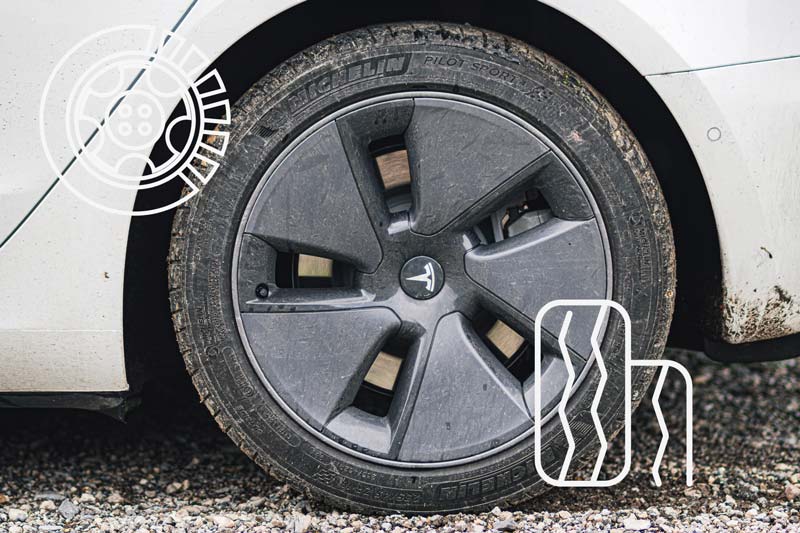
Comparison of Teslas’ Driving Characteristics with Other Vehicles in Its Class
Tesla vehicles are known for their quick acceleration and responsive handling. While these features can be fun to drive, they can also put a significant amount of stress on the tires.
Compared to other vehicles in its class, Tesla cars are generally heavier and more powerful, which can cause them to put more stress on the tires when driving.
Tips to Reduce the Impact of Aggressive Driving
If you’re a Tesla owner with an aggressive driving style, there are some things you can do to reduce the impact on your tires:
- Try to adjust your driving style to be more moderate. This can help reduce the stress on your tires and extend their lifespan.
- Consider upgrading to a tire that’s better suited for your driving style: High-performance tires are designed to withstand more stress and provide better handling at high speeds.
3. Low Rolling Resistance Tires
Tesla vehicles are known for using low rolling resistance tires, which can contribute to quicker tire wear.
What Are Low Rolling Resistance Tires?
Low-rolling resistance tires are designed to reduce the amount of energy required to move a vehicle forward. They do this by using special tread patterns, lighter-weight materials, and stiffer sidewalls to reduce friction between the tire and the road.
This can improve fuel efficiency and reduce emissions, but it can also contribute to quicker tire wear.
Why Teslas Use Low-Rolling Resistance Tires
Tesla vehicles use low-rolling resistance tires to improve their electric range. By reducing the amount of energy required to move the car forward, low rolling resistance tires can help Tesla cars go further on a single charge.
Additionally, they can help reduce the carbon footprint of electric cars, which is one of Tesla’s main missions.
Comparison of Low Rolling Resistance Wheels with Other Types of Wheels in Terms of Lifespan
Low-rolling resistance tires typically have a shorter lifespan than other types of tires. They may also not perform as well in wet or snowy conditions, which can further reduce their lifespan.
How Low Rolling Resistance Contributes to Quick Tire Wear on Tesla Vehicles
Low-rolling resistance tires put more stress on the tire’s contact patch, causing it to wear down more quickly.
Additionally, because low-rolling resistance tires are often made with lightweight materials, they may not be as durable as other types of tires, which can contribute to quick tire wear.
4. Lack of Rotations and Alignments
Regular tire rotations and alignments are important for maintaining the lifespan of your Tesla tires.
Rotating your tires helps ensure that they wear evenly and can extend their lifespan. Aligning your wheels can help ensure that your car drives straight and can reduce stress on your tires, preventing irregular wear.
Neglecting regular tire rotations and alignments can even cause safety issues on the road. Additionally, neglecting these maintenance tasks can void your tire warranty, leaving you responsible for the cost of replacement tires.
As a Tesla owner, you might be wondering if you can trust your Tesla’s tires during an emergency stop. Check out the article I wrote about called “Can I trust Tesla tires during an emergency stop?” for more detailed info.
Comparison of Tesla’s Recommended Maintenance Schedule with Industry Standards
Tesla recommends that owners rotate their tires every 10,000-12,000 miles and have their wheels aligned every 2 years.
This is in line with industry standards, which generally recommend tire rotations every 6,000-8,000 miles and wheel alignments every 1-2 years.
Tips on How to Properly Maintain the Wheels on Teslas to Maximize Their Lifespan
If you’re a Tesla owner, there are some things you can do to properly maintain your car’s tires and maximize their lifespan:
- Follow the recommended maintenance schedule: Tesla recommends that owners rotate their tires every 10,000-12,000 miles and have their wheels aligned every 2 years. Following this schedule can help ensure that your tires wear evenly and can extend their lifespan.
- Inspect your tires for damage: Regularly inspecting your tires for damage, such as punctures, cuts, or bulges, can help prevent tire failure and keep you safe on the road.
Weight Distribution and Alignment Issues
In addition to regular tire rotations and alignments, it’s also important to pay attention to weight distribution and alignment issues on your Tesla.
Improper weight distribution, such as carrying too much weight in one area of the car, can cause uneven wear on your tires.
Misaligned wheels can also cause your tires to wear down more quickly. If you’re experiencing uneven tire wear, consider having your car’s weight distribution and alignment checked by a Tesla service center or a mobile tire repair service.
5. Road Conditions
Road conditions can affect tire wear in a number of ways.
The most common road conditions that contribute to quick tire wear on Tesla vehicles include:
- Rough roads: Rough roads, such as those with a lot of bumps, cracks, or uneven surfaces, can cause your tires to wear down more quickly. This is because the constant jostling and bouncing of the car can put extra stress on your tires, causing them to wear down faster than they would on smoother roads.
- Debris: Debris on the road, such as rocks or broken glass, can cause punctures or cuts in your tires, leading to flat tires or other damage that can shorten their lifespan.
- Potholes: Potholes can cause your tires to wear down more quickly, as well as cause damage to your wheels or suspension.
- Wet or snowy roads: Wet or snowy roads can cause your tires to wear down more quickly, as they have less traction on these surfaces and have to work harder to maintain grip.
Tips for Driving on Roads That Contribute to Faster Tire Wear
If you frequently drive on roads that contribute to quick tire wear, there are some things you can do to help reduce the impact on your Tesla’s tires:
- Avoid rough roads: If possible, look for alternate routes that have smoother surfaces.
- Be mindful of debris: When driving on roads with debris, try to avoid driving over it or slow down to reduce the impact on your tires. If you do hit debris and suspect damage to your tires, have them inspected as soon as possible to prevent further damage.
- Watch for potholes: When driving on roads with potholes, slow down or try to avoid them if possible.
- Consider upgrading to tires with better wet or snowy traction: If you frequently drive on wet or snowy roads, consider upgrading to winter tires or all-season tires with good traction in these conditions.
6. Potential Impact of Tesla’s Regenerative Braking System on Tread Wear
Tesla’s regenerative braking system is one of the most unique features of its electric cars, but it may also have an impact on tire wear.
How Tesla’s Regenerative Braking System Works
Tesla’s regenerative braking system is designed to capture the energy that’s normally lost during braking and use it to recharge the car’s battery. When you hit the brakes, the system activates and converts the kinetic energy of the car’s motion into electrical energy that’s stored in the battery.
This can help improve the car’s overall efficiency and reduce its energy consumption.
Potential Impact on Tread Wear
While the regenerative braking system can be a great way to improve the efficiency of your Tesla, it may also have an impact on tire wear. When you use the brakes, the system can cause the tires to drag slightly on the road, which can lead to increased wear and tear.
This can be especially true if you frequently engage in hard braking, such as when driving in stop-and-go traffic.
Tips to Minimize the Impact on Tread Wear
If you’re concerned about the impact of Tesla’s regenerative braking system on tire wear, there are some things you can do to help minimize it:
- Avoid hard braking: Try to avoid hard braking as much as possible, as this can cause extra wear and tear on your tires. Instead, try to anticipate stops and slow down gradually to reduce the impact on your tires.
- Use “creep” mode: Tesla’s “creep” mode is a setting that causes the car to move forward slowly when you take your foot off the brake. Using this mode can help reduce the amount of time your tires spend in contact with the road, reducing wear and tear.
Solutions for Reducing Tread Wear
If you’re a Tesla owner, you know that tire wear can be a significant expense. However, there are things you can do beyond the tips already discussed above to help reduce the impact of quick tire wear on your Tesla.
Regular Tire Maintenance
Regular tire maintenance can also help reduce tire wear on your Tesla. Here are some tips to keep your tires in good condition:
- Rotate your tires: Regularly rotating your tires can help ensure even wear and extend their lifespan.
- Check tire pressure: Keeping your tires inflated to the proper pressure can help improve their lifespan and improve your car’s overall efficiency.
- Get regular alignments: Regular alignments can help ensure your tires wear evenly and reduce the risk of damage to your suspension or wheels.
- Consider a tire repair or replacement service: If your tires are worn down or damaged, consider taking your car to a Tesla service center or a mobile tire repair service to get them fixed or replaced.
- Consider upgrading your tires: Some Tesla models come with summer tires, which may wear out more quickly than all-season or winter tires. Consider upgrading to a tire that’s better suited for your driving style and the weather conditions in your area.
Alternative Tire Options
There are a number of alternative tire options that may have longer lifespans than the tires that come with your Tesla. Here are some options to consider:
- High-performance tires: High-performance tires are designed to withstand more stress and can be a good choice if you frequently engage in hard braking or live in an area with poor road conditions.
- All-season tires: All-season tires are a good choice if you live in an area with changing weather conditions, as they’re designed to provide good traction in a variety of conditions.
- Winter tires: Winter tires are designed to provide better traction in snowy or icy conditions, making them a good choice if you live in an area with harsh winters.
On a that note, I’ve written an article about Tesla tire quality and performance that you won’t want to miss. Learn everything you need to know about choosing the right tires for your Tesla and how to ensure optimal performance and safety.
You can use this online Tesla tire calculator to find how long any Tesla Model tire will last. You can also estimate the number of miles left on your current set and how many days you have until they need to be swapped out for new ones. If that is the case, you can also find the price for any set of Tesla tires by selecting the appropriate tires. Have fun!
Check out these 20 great gift ideas for yourself or a Tesla fanboy.
Contact Us if you have any questions or queries.


